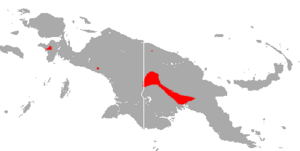Wollaston's roundleaf bat facts for kids
Quick facts for kids Wollaston's roundleaf bat |
|
|---|---|
| Conservation status | |
| Scientific classification | |
| Genus: |
Hipposideros
|
| Species: |
wollastoni
|
 |
|
| Wollaston's roundleaf bat range | |
The Wollaston's roundleaf bat (Hipposideros wollastoni) is a type of bat. It belongs to the family Hipposideridae, which are often called "leaf-nosed bats" because of their unique nose shapes. You can find this bat in West Papua, Indonesia and Papua New Guinea. It was named after a famous explorer, Sandy Wollaston.
Contents
Meet the Wollaston's Roundleaf Bat
This bat was first officially described in 1913. A British zoologist named Oldfield Thomas gave it its scientific name. The bat's name, wollastoni, honors Sandy Wollaston, who was an explorer. The very first bat of this species that scientists studied was found during one of Wollaston's trips to New Guinea.
What Does It Look Like?
The Wollaston's roundleaf bat looks a lot like another bat called the Fly River roundleaf bat. However, there's one special difference. The Wollaston's bat has a "peculiar duplication" behind its back nose-leaf. This means it has an extra fold of skin on its nose.
Here are some measurements for this bat:
- Its forearm is about 44 mm (1.7 in) long.
- Its head and body together measure about 45 mm (1.8 in).
- Its tail is about 27 mm (1.1 in) long.
- Its ears are about 15 mm (0.59 in) long and 13 mm (0.51 in) wide.
Where Do They Live?
Wollaston's roundleaf bats only live on the island of New Guinea. This island is split between Indonesia and Papua New Guinea. These bats have been found living at many different heights, from 30 m (98 ft) up to 2,440 m (8,010 ft) above sea level.
They like to live in different kinds of forests. You might find them in mountain forests, oak forests, or even secondary forests. Secondary forests are areas where trees have grown back after being cut down.
Conservation Status
The IUCN (International Union for Conservation of Nature) keeps track of how many animals are left in the wild. They have listed the Wollaston's roundleaf bat as a "least concern" species. This is the lowest conservation priority. It means that, for now, there are enough of these bats in the wild, and they are not in danger of disappearing.


